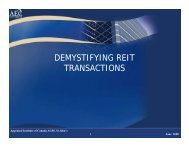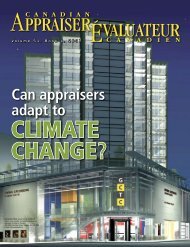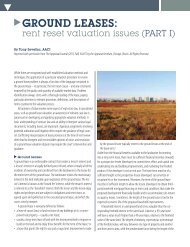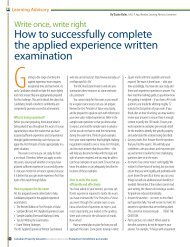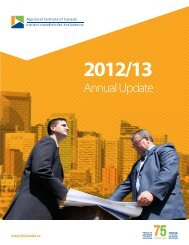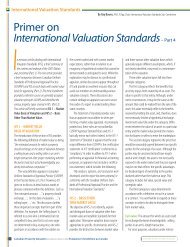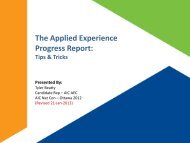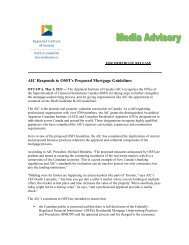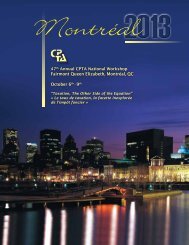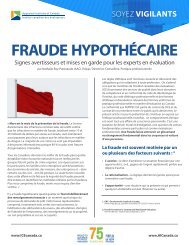Book 4 - Appraisal Institute of Canada
Book 4 - Appraisal Institute of Canada
Book 4 - Appraisal Institute of Canada
You also want an ePaper? Increase the reach of your titles
YUMPU automatically turns print PDFs into web optimized ePapers that Google loves.
AdjudicatingThe Standards revisitedBy John Ingram, AACIChair, Adjudicating CommitteeChanges to the regulations governingpr<strong>of</strong>essional practice have led to achange in the types <strong>of</strong> complaintsthat actually find their way to a hearing beforethe Adjudicating Committee and most chargesreflect only the more serious <strong>of</strong> ethical andstandards breaches. Except in the rare cases<strong>of</strong> willful disregard for pr<strong>of</strong>essional standards,the root causes for complaints can be foundin incomplete or incorrect application <strong>of</strong>the Ethics Standard Rules and the <strong>Appraisal</strong>Standard Rules. The changes to the regulationshave not changed the underlying issues resultingin complaints.<strong>Appraisal</strong> Standard RulesWhile all <strong>of</strong> the <strong>Appraisal</strong> Standard Rules shouldbe addressed in an appraisal, there are a fewwhich occasionally receive less attention thanthey deserve, which leads to potential errors.In some cases, there is no error in terms <strong>of</strong> thefacts, but, rather, a failure to clearly communicatethe situation in the report. Either case canlead to subsequent complaints.• SR 6.2.10 and 6.2.11 deal with identifyingall assumptions, limiting conditions andhypothetical conditions. A typical boilerplatearray <strong>of</strong> assumptions and conditions is usefulin many circumstances, but it is importantto make sure that the standard clauses arerelevant to the case at hand. If they are notrelevant, then they should be removed fromthe report. Case-specific assumptions andconditions need to be clearly laid out so thatit is clear to the client and any other user<strong>of</strong> the report exactly what the basis for theconclusions has been. There should be aclear understanding between the client andthe appraiser <strong>of</strong> exactly what assumptions“The Standards, or lack<strong>of</strong> attention to them,is at the heart <strong>of</strong> mostpr<strong>of</strong>essional practicecomplaints. “and conditions will be required to properlyaddress the specific case.• SR 6.2.23 and 6.2.24 involve analyzing agreement<strong>of</strong> sale, option or listing <strong>of</strong> the propertyas well as any prior sales <strong>of</strong> the property.These factors are key representations <strong>of</strong> themarket in which the property is trading. Failto seek out and report them at your peril.Ethics Standard RulesBreaches <strong>of</strong> some <strong>of</strong> the <strong>Appraisal</strong> Standard Rulescan, by extension, lead to allegations <strong>of</strong> EthicsStandard Rules violations. However, outside <strong>of</strong>willfully disregarding the Standards, or fraud,there are three key areas that lead to problems:• ER 4.2.6 relates to improperly claiming qualifications.The issue <strong>of</strong>ten resulting in chargeshas been dealt with before in this space, butit is worth a reminder. Members holding theCRA designation can appraise only individual,undeveloped residential dwelling sites anddwellings containing not more than four selfcontainedfamily housing units. If you areappraising a property outside <strong>of</strong> this group,simply dropping your CRA designation is notacceptable. The report must be co-signed byan AACI. If you are in doubt about whether aproperty falls within the scope <strong>of</strong> practice <strong>of</strong>a CRA, check with the <strong>Institute</strong>.• ER 4.2.8 involves refusal to co-operate withthe <strong>Institute</strong>. In the course <strong>of</strong> investigating acomplaint, you will likely be asked to providecertain information. To refuse to do this orto delay beyond reasonable amounts <strong>of</strong> timeprovided will likely lead to a suspension untilthe requirements are met.• ER 4.2.9 deals with creating a workfile foreach assignment. If you are asked for yourworkfile as part <strong>of</strong> an investigation, there isan expectation that it contains more thana copy <strong>of</strong> the appraisal report in question.Other key items would include field notes,information on selected comparablesand notes on any conversations or otherproperty-specific data obtained in the course<strong>of</strong> the appraisal. Comment 5.9 provides additionaldetail on the expected contents <strong>of</strong> theworkfile. These workfiles must be retainedfor a minimum <strong>of</strong> seven years.The Standards, or lack <strong>of</strong> attention to them,is at the heart <strong>of</strong> most pr<strong>of</strong>essional practicecomplaints. This is a brief look, but it highlightswhere some <strong>of</strong> the more serious areas<strong>of</strong> concern can arise. For every assignment, itis important to always keep in mind the broadfundamentals reflected in the Standards.Adjudicating CommitteeJohn Ingram, AACI – ChairVesa Jarvela, AACIMichael Wootton, AACIPat Cooper, AACIKenneth Smith, AACIMichael Scichilone, AACITo contact this committee, email:adjudicating@aicanada.caclick here to return to table 0f contentsCanadian Property Valuation Volume 54 | book 4 | 2010 Évaluation Immobilière au <strong>Canada</strong> 41



